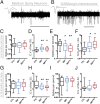Selective expression of mutant huntingtin during development recapitulates characteristic features of Huntington's disease
- PMID: 27140644
- PMCID: PMC4878495
- DOI: 10.1073/pnas.1603871113
Selective expression of mutant huntingtin during development recapitulates characteristic features of Huntington's disease
Abstract
Recent studies have identified impairments in neural induction and in striatal and cortical neurogenesis in Huntington's disease (HD) knock-in mouse models and associated embryonic stem cell lines. However, the potential role of these developmental alterations for HD pathogenesis and progression is currently unknown. To address this issue, we used BACHD:CAG-Cre(ERT2) mice, which carry mutant huntingtin (mHtt) modified to harbor a floxed exon 1 containing the pathogenic polyglutamine expansion (Q97). Upon tamoxifen administration at postnatal day 21, the floxed mHtt-exon1 was removed and mHtt expression was terminated (Q97(CRE)). These conditional mice displayed similar profiles of impairments to those mice expressing mHtt throughout life: (i) striatal neurodegeneration, (ii) early vulnerability to NMDA-mediated excitotoxicity, (iii) impairments in motor coordination, (iv) temporally distinct abnormalities in striatal electrophysiological activity, and (v) altered corticostriatal functional connectivity and plasticity. These findings strongly suggest that developmental aberrations may play important roles in HD pathogenesis and progression.
Keywords: neurodegeneration; plasticity; prodromal.
Conflict of interest statement
The authors declare no conflict of interest.
Figures










References
-
- Cummings DM, et al. Aberrant cortical synaptic plasticity and dopaminergic dysfunction in a mouse model of Huntington’s disease. Hum Mol Genet. 2006;15(19):2856–2868. - PubMed
Publication types
MeSH terms
Substances
Grants and funding
LinkOut - more resources
Full Text Sources
Other Literature Sources
Medical
Molecular Biology Databases

